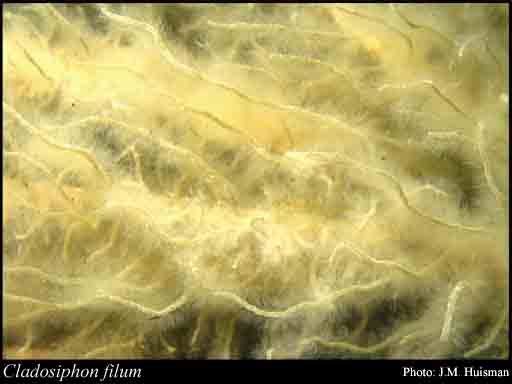- Reference
- Acta Univ.Lund. 29 (1940)
- Conservation Code
- Not threatened
- Naturalised Status
- Native to Western Australia
- Name Status
- Current

Scientific Description
Habit and structure. Thallus medium to dark brown, very mucoid, simple or with one to a few laterals, 10–50 cm long and (1–)2–4(–6) mm in diameter, with a small discoid holdfast 0.5–2 mm across, epiphytic usually on Posidonia or Amphibolis. Basal system of juvenile plants consisting of a pseudoparenchymatous layer of filaments, producing the core of erect medullary filaments. Medulla becoming hollow, of more or less parallel longitudinal cylindrical filaments 25–50(–80) µm in diameter with cells L/B (1–)2–4(–6), with only a few hyphae but with slightly slenderer filaments of shorter cells (L/B 1–2) on the periphery; the latter develop further with age, originating from the outer, larger, medullary filaments or the basal cells of the subcortex. Subcortex slight, 20–60(–80) µm broad and usually of 1–3 cells (branched if 2 or 3) at right angles to medullary cells, cells ovoid to elongate ovoid, (10–)20–30 µm in diameter and L/B 1–2. Cortical filaments arising singly or in groups from outer subcortical cells or directly from peripheral medullary cells, simple, determinate, 400–500(–800) µm and usually 20–30(–45) cells long, curved to recurved above; upper cells 8–12 µm in diameter and L/B 0.7–1.5(–2), ovoid or extended on their upper sides, lower cells cylindrical, 6–10 µm in diameter and L/B 4–8. Phaeoplasts several per cell, discoid, each with a pyrenoid; cells with numerous physodes. Phaeophycean hairs frequent, arising from outer subcortical cells, (16–)20–25(–30) µm in diameter.
Reproduction. Plurilocular sporangia produced from upper cells of curved cortical filaments by successive subdivisions on their upper side to form a cluster 10–20 µm long. Unilocular sporangia on the same or different plants, borne on outer subcortical cells, ovoid, 80–100 µm long and 60–80 µm in diameter.
Distribution. From Saftey Bay, W. Aust., to Twofold Bay, N.S.W. and around Tas.
Habitat. On Posidonia spp. and Amphibolis in the sublittoral, rarely on larger algae (e.g. Scaberia), under moderate wave action. It is often common in the upper sublittoral but is recorded to a depth of 26 m.
Cladosiphon filum is one of the more common Chordariaceae, present on the more robust seagrasses during summer months (September to March).
[After Womersley, Mar. Benthic Fl. Southern Australia II: 120–122 (1987)]
Distribution
- IBRA Regions
- Esperance Plains.
- IBRA Subregions
- Recherche.
- IMCRA Regions
- Leeuwin-Naturaliste.
- Local Government Areas (LGAs)
- Esperance, Rockingham.